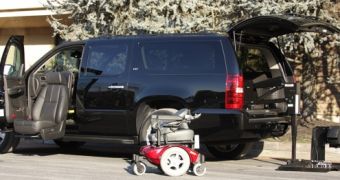The system proposed by Freedom Sciences, a company commercializing motorized wheelchairs along with a modified Chrysler minivan, uses automatic devices to open and close the doors of the car, to lower the seat of the driver and load the robotic wheelchair at the push of a button. Once the driver reaches the designated destination the process is reversed so that the wheelchair can be unloaded from the car and position itself near the driver's seat, to give him more freedom.
The whole system is commanded by remote control, except for docking the wheelchair, which is done automatically with the help of radio and laser guided systems. The automated docking system was developed by Freedom Sciences in collaboration with researchers from Lehigh University in Bethlehem, Pennsylvania, US.
100 percent reliability
The system was originally designed so that the driver could dock the robotic wheelchair by remote control, but it proved too difficult to operate even while being provided with images of the back of the van. "The real challenge is to dock with 100 percent reliability. That is something you can't do with remote control", says Lehigh University robotics expert John Spletzer.
Therefore a LIDAR, or light detecting and raging system, was adopted to do the job for the driver. The position of the wheelchair is precisely relayed to the computer system through a set of two laser beam reflectors positioned on the armrests of the chair.
Jules Verne ATV
A similar system was successfully tested this month on ESA's Jules Verne Automated Transfer Vehicle, which docked with the International Space Station on April 3. During the tests on the robotic wheelchair, researchers reported a 97.5 percent success rate be it in heavy rain, high concentrations of visible fumes or loose gravel. But even if the system fails to dock the wheelchair at first attempt, there is a high probability that it succeeds in the second attempt. Alternatively, if the system is malfunctioning the driver can take over by remote control.
Once it is approved by the US Food and Drug Administration, the system can be commercialized at a price of about 30,000 US dollars. It may seem rather expensive, but the cost is comparable to that of other modified vehicles and wheelchairs currently available on the market, and it can also be transferred in case the owner decides to change his car.

 14 DAY TRIAL //
14 DAY TRIAL //